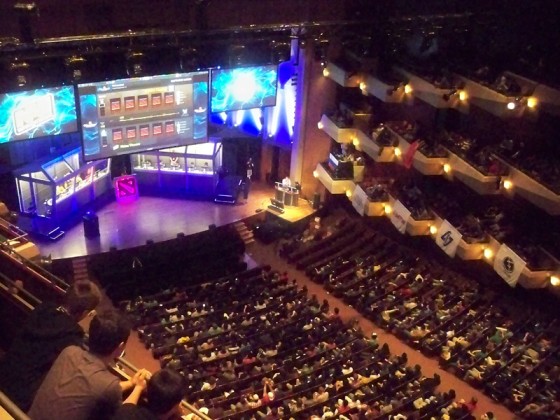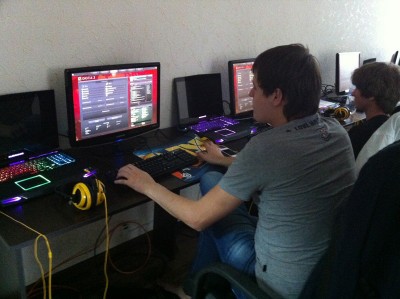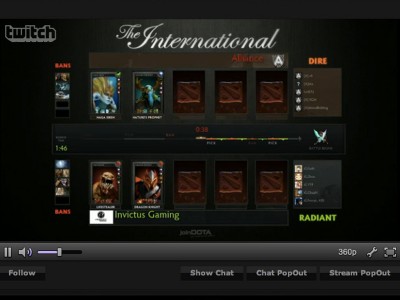 You might see an unexpected crowd at Benaroya Hall over the next few days. Professional video gamers from all over the world will be there competing for the top prize of $1.4 million.*
You might see an unexpected crowd at Benaroya Hall over the next few days. Professional video gamers from all over the world will be there competing for the top prize of $1.4 million.*
On Monday I watched one of the preliminary matches in the International 3. It was a webcast of two teams playing a video game. Sixty-six thousand people were watching online. And that was just the English version. Another 66,000 were watching in Russian. Still others were watching in German. Not to mention the three other games being played and watched simultaneously. Other broadcasts were in Chinese, Korean and Portuguese.

The game is an elaborate fantasy battle with complicated characters, and the players are professionals. Their lives are almost the same as any pro athlete. For serious gamers, it’s not just a game, it’s a sport. In fact, it’s a whole new category known as eSports.
Clement Ivanov is the captain of a professional team known as Natus Vincere (aka Na’Vi) — Latin for ‘born to win.’ At 22, he’s been a pro for six years.
“I’m not in a job like in a business where I can pretty much eat anything, feel bad, take a sick day,” he said, sitting in his Bellevue hotel room the day before the preliminaries began. “There’s no sick days in my life! If I have a sick day my team might lose or get disqualified and we’re out.”
Na’Vi won the first International, two years ago. Last year they came in second. This year they’re one of the top-ranked teams going into the finals.
Na’Vi trains in Kiev, Ukraine. I visited them there last year. They have the penthouse suite in a Soviet-looking but brand-new high-rise at the edge of the city.
The first thing you see when you walk in is the huge trophies the team has won.
Ivanov told me about a typical training day: “We wake up 2, 3 pm. Go eat at some restaurant, come here, relax a little bit – 15 minutes – and then we start playing. “

The team plays at a row of five computers in a bare room with a long wooden desk and not much else. As captain, Ivanov sits in the middle.
It might sound like a dream job: sleeping in, playing video games all day. But it’s eight hours a day of serious practice, scrimmaging with other pro teams from all over the world.
The game they play is called DOTA 2. If you’ve heard of League of Legends, it’s the same kind of thing. They’re known as MOBA’s: Multiplayer Online Battle Arenas.
My younger brother, a graduate student in theoretical linguistics at CUNY, has been playing computer games since middle school. I called him up for help understanding the world of DOTA.

“It’s like a war game,” he told me. “They’re trying to accumulate resources, in order to build better weapons, in order to attack each other’s bases…”
Tyler helped answer my biggest question: why would you ever want to sit around watching someone else play video games??
“It’s complex, it’s team based, it’s strategic and it’s fast-paced. It’s just got a lot of exciting stuff going on,” he said.
In other words it’s a lot more like watching people play basketball than like watching people play Tetris.
The first thing you do in every game of DOTA2 is pick which character to play–kind of like choosing the shoe or the iron in Monopoly, Tyler explained, “except imagine that the iron had the ability to always land on free parking if you rolled a six and the shoe had the ability to move twice as far as he rolled.”
…or to breathe fire, or create a vortex, or fly.
Twenty million players are registered to play. In an average month 5.4 million play the game. It only takes a minute or two to get a pickup game of ten people started. Tyler thinks it’s edging toward the mainstream.
“I definitely see it as something that could take off as a spectator sport. And you know–even be on TV.”
In May, two professional League of Legends players were awarded P-1 visas. It’s the same visa that major league baseball players get.
For eSports, that new standard for visas is a big step toward the mainstream.
*Note: at time of publication the total prize pool was $2.8m; teams coming in first through eighth in the tournament will take home a cash prize.

